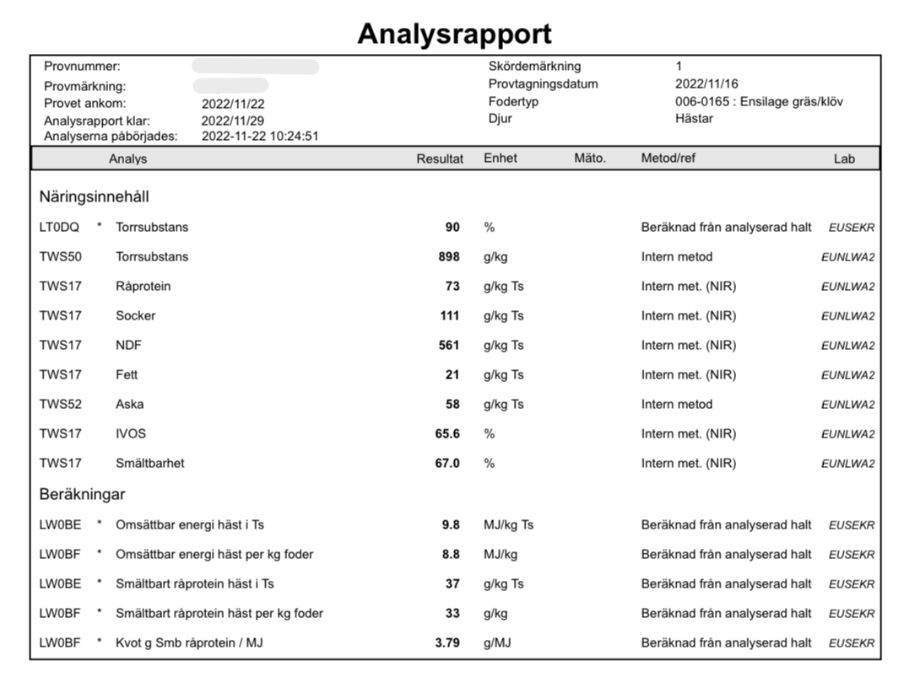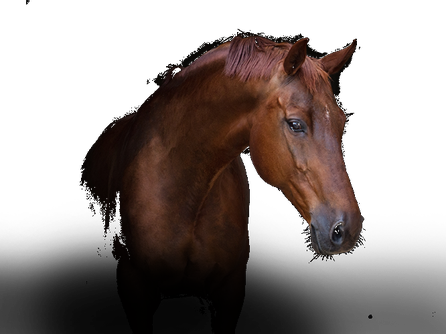Analysis and Feeding plan
Feed advisors often emphasize the importance of analyzing your forage and calculating a proper feed ration. But is it really that important? Here we clarify the significance of a forage analysis and what a feed ration actually includes.
Forage
Forage should form the foundation of the feed ration, and its nutritional value determines whether and how the ration needs to be supplemented. A forage analysis reveals the contents of dry matter, energy, protein, fiber, sugar, and minerals. These values are then used to calculate how much forage the horse should eat.
There are many factors that affect the nutritional content of forage. The most significant is the harvest timing, but the types of grasses and legumes in the field also play a role. Fertilization, hours of sunlight, and rainfall also affect the outcome. In other words, one cannot assume that the nutritional content will be the same year after year, even if the field is managed identically. Analyses should be performed annually and for each harvest.
Variations can occur within a field, so ideally the sample should be taken during baling. Walk diagonally across the field and collect samples from several windrows to get an average value. Sampling just before baling also gives a representative dry matter content.
If you purchase your forage, you may not be able to sample during baling. In that case, take samples from bales at a later time. One tip is to collect from newly opened bales, freeze the samples, and continue collecting until you have samples from at least four bales. The downside to this method is that you've already bought the forage—and what if it turns out to be unsuitable for your horses? The best option is always to buy analyzed forage to avoid buying a pig in a poke!
Remember, a forage analysis is not a quality stamp—it's simply a receipt of the nutritional content. Hygienic quality is equally important. If you need help interpreting your analysis, you’re welcome to contact Trikem’s advisors.
Feeding plan
Horses need energy, protein, and other essential nutrients to function properly, both physically and mentally. They also need the stamina to perform the work we ask of them. To ensure they get everything they need, a properly calculated feed ration is necessary.
When calculating a feed ration, you start by estimating the horse’s energy needs. To do this, you need to know the horse’s weight, body condition, and workload. For adult horses, protein requirements are always six times the energy requirement.
Example: If a horse has an energy need of 50 megajoules (MJ) of digestible energy, it requires 50 × 6 = 300 grams of digestible crude protein (g dcp)
To get a good indication of whether your forage is high or low in protein, divide the protein content (g dcp) by the energy content (MJ digestible energy).

Example:
Vi använder analysen ovan. Enligt den analysen innehåller just detta foder 37 g smb rp / kg torrsubstans (ts) och 9,8 MJ omsättbar energi / kg ts. För att bäst jämföra olika grovfoder räknar man alltid näringsinnehåll per kilo ts, inte per kilo foder.
För att räkna ut protein/energi kvoten i fodret delar vi proteininnehållet med energiinnehållet
37 g smb rp/ 9,8 MJ = 3,8 g smb rp/MJ
I det här exemplet blev kvoten 3,8 vilket är för lågt och det behövs ett tillskott i form av protein.
Hade kvoten blivit betydligt högre än 6 innebär det ett proteinöverskott och då kan det vara lämpligt att minska givan och istället komplettera med t.ex. halm för tillgodose hästens behov av fibrer och förslagsvis en olja för extra energi.
Om grovfodret har en bra balans mellan protein och energi, alltså ett grovfoder som har en kvot på 6 så kan man, beroende på hästens behov, klara sig långt på grovfodret men man kommer alltid behöva komplettera med mineraler och vitaminer. Ett grovfoder är aldrig heltäckande var det gäller hästens vitamin och mineralbehov. Vissa grovfoder kan möta hästens behov av några specifika mineraler såsom kalcium eller fosfor, men behovet av mikromineraler täcks sällan eller aldrig av bara grovfoder.
Behöver du hjälp med att beräkna en foderstat? Vi på Trikem hjälper mer än gärna till,
- Minerals provide the horse with essential minerals, and Vitamins supply vital vitamins. Specific mineral and vitamin supplements in the range are designed to be tailored to individual needs and feed rations.
- Protein Complex is a highly concentrated protein supplement containing all essential amino acids, made from Swedish ingredients. With a very low content of sugar and starch, and added prebiotics, it is gentle even for sensitive horses.
- Energy Oil is a gentle form of energy, completely free from sugar and starch. It contains MCT oils, which allow the horse to quickly and efficiently absorb the energy.



